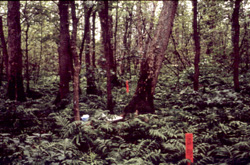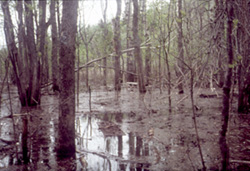Black ash populations on Lake Duparquet
 The
reconstruction of water level fluctuations of Lake
Duparquet using dendrochronological analyses has shown
that the number of scars caused by flood ice during
spring thaws has increased since the end of the Little
Ice Age, around 1850 (fig. 1a). This increase is especially
marked in the 20th century and most notably since the
1930s. The
reconstruction of water level fluctuations of Lake
Duparquet using dendrochronological analyses has shown
that the number of scars caused by flood ice during
spring thaws has increased since the end of the Little
Ice Age, around 1850 (fig. 1a). This increase is especially
marked in the 20th century and most notably since the
1930s.
Parallel to the increase in the
number of ice scars, water levels during spring thaws
have also undergone a progression (fig. 1b). Since
ca. 1915, for example, the spring water level is generaly
about a metre higher than at the end of the Little
Ice Age. Climate studies have shown that the faster
the autumn freeze-up and the greater the winter and
spring precipitation, the higher the water level and
the greater the ice activity during spring thaw.
The observed rise in spring thaw water levels also
influences the dynamics of forest stands situated on
flood plains. The study of black ash stands revealed
that, in sites most exposed to high flood waters, individuals
are maintained primarily by vegetative reproduction
(stump sprouts) whereas sexual regeneration is much
more prevalent in sites where flood conditions are
less severe.

Vegetative regeneration is an important mechanism
with which black ash manages to maintain itself on the lake (fig. 1d). Black
ash populations on Lake Duparquet are stable, with individuals in all
age classes. Contrary to the virtual disappearance of black ash on Lake
Abitibi following construction of a hydroelectric dam at Iroquois Falls
around 1915-1920, the rise in the water level in Lake Duparquet has been
gradual, thus permitting populations to shift their locations. This phenomenon
clearly indicates the exceptional character of Lake Duparquet which, in
the absence of man-made controls on its water levels, has managed to preserve
the natural character of its shoreline.
Contrary to what we might think, it appears that the increase in
spring thaw water levels in Lake Duparquet has not had a negative effect on the growth of
black ash. Rather, growth conditions seem to have improved since the beginning of this
century, despite an increase in the number and height of ice scars (fig. 1c).
Dendroclimatological studies have shown that only high flood waters that persist into the
beginning of the growing season (June) have a negative effect on radial growth of the
species. For black ash, early flooding may have a positive effect on growth by prolonging
the growing season, especially if precipitation in June is heavy (Tardif et Bergeron,
1992 ; Tardif et Bergeron, 1993 and Tardif et al., 1994).

Fig. 1. a) Number of ice scars in five-year classes (n=616) and accumulated
curves of scar frequency (n=616) and age of scar-bearing trees (n=81).
b) Evolution of maximum height (n=122) attained by scars since the end
of the 17th century. c) Black ash growth index curve for all Lake Duparquet
sites with no. of trees (153 max.). d) Age structure of black ash in Lake
Duparquet (6 stands) in 10-year age classes and according to origin (sexual
or vegetative).
|

|